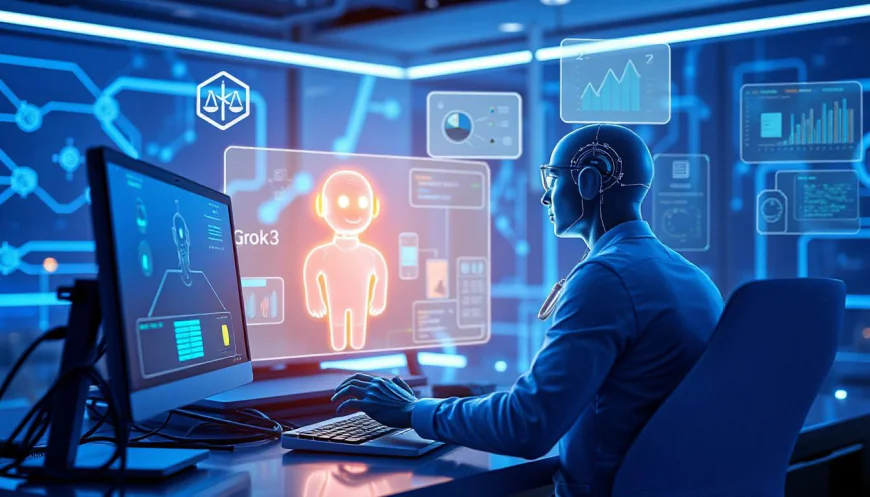Grok 3 & ChatGPT: Exploring the Latest AI Tools and Their Impact on Technology and Society
AI tools like Grok 3 and ChatGPT are making waves. Their rapid growth pushes smart machines into everyday life faster than ever. These tools are now essential for many businesses and individuals. But what makes them special? How do they differ? And what are the ethical questions they bring up? Understanding these AI innovations is key for anyone interested in the future of tech and society.

What Are Grok 3 and ChatGPT? An Overview of Next-Generation AI Tools
Understanding Grok 3
Grok 3 is developed by DeepMind, a leader in AI research. It's designed to be smarter and more adaptable than older models. With Grok 3, AI can better understand complex problems and learn new skills rapidly. Improved models help in areas like problem-solving and decision-making, making it a powerful tool for industries like healthcare and robotics.
Exploring ChatGPT
OpenAI created ChatGPT, part of the GPT series. Its main strength is chatting naturally with humans. GPT-4, the latest version, can generate responses that sound very human-like. It handles tasks like content writing, customer service, and even coding. ChatGPT’s ability to understand context makes it useful for many applications.
Comparing the Core Technologies
Both Grok 3 and ChatGPT are based on transformer models, but they differ in focus. Grok 3 is built for complex reasoning and learning, while ChatGPT is tuned for language and conversation. Grok 3 handles multi-tasking with ease, whereas ChatGPT excels at understanding and generating language. User feedback shows Grok 3 is strong in solving technical problems, while ChatGPT shines in dialogue and content creation.
How Are Grok 3 and ChatGPT Changing the AI Landscape?
Advancements in Natural Language Processing
AI's ability to understand context improved a lot recently. Responses are more accurate and relevant. For example, customer service bots now handle complex questions better. Content creators also benefit from AI tools that help draft articles or assist with editing, making workflows faster.
Impact on Industries
- Healthcare: AI helps doctors diagnose illnesses faster. Patients get personalized health advice through chatbots.
- Education: AI-powered tutors provide lessons tailored to student needs. Automated grading saves teachers time.
- Business: Routine tasks like data entry or scheduling get automated. Companies analyze data more efficiently, boosting productivity.
Adoption Statistics and Future Trends
AI tools are growing fast. Market reports say the AI industry will double in size over the next five years. Industry leaders predict more AI integration into daily tech gadgets, making AI a common part of life. Expect AI to become smarter, with better tools helping us in both work and leisure.
Ethical and Societal Debates Surrounding Advanced AI Tools
Privacy and Data Security Concerns
AI models need lots of data. That raises worries about personal privacy. If sensitive info is used improperly, users risk data theft or misuse. Companies now work to pick data carefully and protect user info with encryption and strict rules.
Bias and Fairness in AI Responses
AI can sometimes reflect biases found in training data. For example, responses may unintentionally favor certain groups. Developers fight this by cleaning data and testing AI responses for fairness. Reducing bias is critical to making AI trustworthy and fair.
AI Governance and Regulation
Laws regulate AI use but are still catching up. Governments need clear rules on privacy, fairness, and accountability. International groups are calling for global standards so AI is used responsibly across borders. Tech companies also play a role in setting ethical guidelines.
Ethical Use Cases and Potential Misuse
AI can do good, like helping diagnose diseases or improving education. But it can also be misused—deepfakes and misinformation are big risks. Responsible AI use means understanding these threats and taking steps to prevent harm. Always ask: is this AI helping or hurting society?
Comparing AI Capabilities: Grok 3 vs. ChatGPT
Strengths and Limitations
Grok 3 is strong at solving complex problems and understanding new concepts. However, it needs more training data for specific tasks. ChatGPT is easier to use for language-based tasks but sometimes struggles with nuance or deep understanding.
Practical Use Cases
- Grok 3: Good for developing advanced robotics, AI research, or complex simulations.
- ChatGPT: Best for customer service, content creation, and virtual assistants.
Case studies show Grok 3’s potential in automating tasks requiring reasoning, while ChatGPT excels where human-like conversation is needed.
Future Development Directions
Expect both tools to improve. Grok 3 might gain more reasoning skills, and ChatGPT could become better at understanding subtle context. They might also work together with other tech, like robotics or sensors, opening new possibilities.
How to Stay Ahead with AI Tools: Tips for Developers and Businesses
- Regularly update models to keep pace with new advances.
- Test AI for bias and fairness before deployment.
- Follow emerging AI trends through blogs, conferences, and research papers.
- Work with ethicists and policymakers to shape responsible AI use.
Conclusion
Grok 3 and ChatGPT are shaping the future of AI. They push technological limits and bring many benefits. But with this progress, ethical questions arise. Protecting privacy, fighting bias, and creating clear rules are essential. Staying informed and responsible is key for everyone involved in AI. As these tools grow smarter, so must our understanding and regulations. The goal is to use AI in ways that help society and respect human values. Keep learning about these tools—there’s a lot of potential to unlock in their development.



 VARSHITHA
VARSHITHA